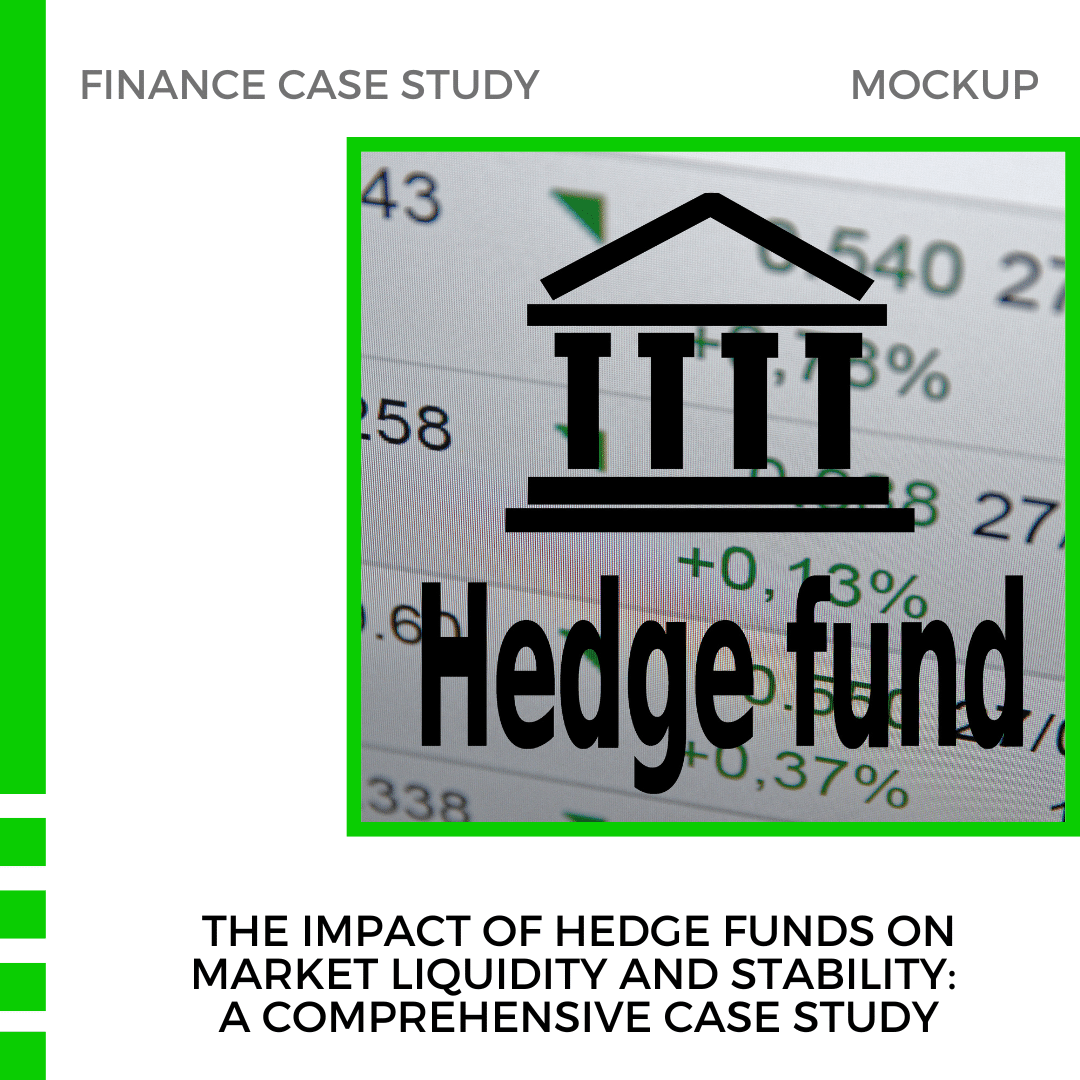
The Impact of Hedge Funds on Market Liquidity and Stability: A Comprehensive Case Study
Introduction
Hedge funds are pooled investment vehicles known for their ability to enhance market liquidity and influence market stability. To generate high returns, these funds employ sophisticated strategies—such as long/short equity, global macro, and event-driven investing. While hedge funds contribute to the efficient functioning of financial markets, they also introduce risks that must be carefully managed. This case study examines the impact of hedge funds on market liquidity and stability, analyzes regulatory challenges, and proposes future recommendations.
Objectives
- Understand the role of hedge funds in financial markets.
- Analyze how hedge funds contribute to market liquidity.
- Evaluate the positive and negative implications of hedge fund activities on market stability.
- Discuss regulatory challenges and future regulatory measures for hedge funds.
Background Information
Key Concepts
- Hedge Funds: Pooled investment funds that use various strategies such as leverage, short selling, and derivatives to generate high returns.
- Market Liquidity: The ease with which an asset can be bought or sold without causing a significant change in its price.
- Market Stability: The ability of financial markets to absorb shocks and maintain orderly functioning without excessive volatility.
Hedge Fund Strategies
- Long/Short Equity: Combines long positions in undervalued stocks and short positions in overvalued stocks to profit from price changes.
- Global Macro: Trades across asset classes by leveraging macroeconomic trends, including interest rates and political events.
- Event-driven: Focuses on opportunities from corporate events, such as mergers or bankruptcies.
- Relative Value: Exploits price discrepancies between related securities, such as bonds from the same issuer.
Key Financial Metrics
- Assets Under Management (AUM): The total value of assets a hedge fund manages.
- Turnover Ratio: Measures how frequently assets are traded within a portfolio.
- Liquidity Ratio: Indicates the proportion of a fund’s portfolio that can be quickly converted into cash.
Hedge Fund Contributions to Market Liquidity
Case Example 1: Long/Short Equity Fund
Hedge Fund A: Equity Masters LLC
- Strategy: Long/Short Equity
- AUM: $5 billion
- Turnover Ratio: 150% annually
- Liquidity Ratio: 70%
Market Impact:
- Provides liquidity through frequent trading of undervalued and overvalued stocks.
- Enhances price discovery by identifying mispricings and narrowing bid-ask spreads.
- Reduces volatility by mitigating extreme price movements through both long and short positions.
Case Example 2: Global Macro Fund
Hedge Fund B: Global Insights Fund
- Strategy: Global Macro
- AUM: $10 billion
- Turnover Ratio: 100% annually
- Liquidity Ratio: 60%
Market Impact:
- Injects liquidity across multiple asset classes, including bonds, currencies, and commodities.
- Provides market stability by hedging risks during periods of economic uncertainty.
- Acts as a stabilizing force during financial crises by exploiting macro trends and cushioning market volatility.
Implications for Market Stability
Positive Contributions
- Enhanced Liquidity: Hedge funds facilitate trading, ensuring that markets remain active and liquid.
- Improved Price Discovery: By analyzing market trends, hedge funds help set more accurate prices for assets.
- Risk Management: Hedge funds use hedging strategies to reduce risks, contributing to overall market stability.
Negative Implications
- Excessive Volatility: Aggressive trading strategies can create short-term price swings, leading to instability.
- Systemic Risk: High leverage increases the risk of contagion during market downturns.
- Market Manipulation: Hedge funds can potentially manipulate prices through large speculative trades.
Regulatory Challenges
Current Regulatory Landscape
- Dodd-Frank Act: Imposes transparency requirements and limits systemic risks.
- Volcker Rule: Prohibits proprietary trading by banks to minimize conflicts of interest.
- Alternative Investment Fund Managers Directive (AIFMD): Ensures better risk management and transparency for European hedge funds.
Regulatory Issues
- Transparency: Limited disclosure of hedge fund positions increases opacity in financial markets.
- Leverage Control: Excessive leverage magnifies losses and risks.
- Systemic Risk Monitoring: Regulators face challenges in identifying risks posed by hedge fund interconnectedness.
Case Study Analysis
Task 1: Evaluate Hedge Fund Contributions to Liquidity
- Analyze Liquidity Metrics:
- Equity Masters LLC: Higher turnover ratio (150%) and liquidity ratio (70%) indicate significant market participation and liquidity provision.
- Global Insights Fund: Moderate turnover (100%) and liquidity (60%) show steady contribution across multiple asset classes.
- Impact on Market Depth:
- Both funds enhance market depth by narrowing bid-ask spreads and facilitating smooth transactions.
- The Equity Masters LLC fund improves price discovery by capitalizing on stock mispricings.
Task 2: Assess Implications for Market Stability
- Positive Impacts:
- Hedge funds stabilize markets by providing liquidity during periods of stress.
- For instance, during the 2008 financial crisis, several macro hedge funds helped cushion market volatility.
- Negative Implications:
- Examples like Long-Term Capital Management’s (LTCM) collapse in 1998 demonstrate how interconnectedness and leverage can amplify risks.
- Such failures highlight the need for systemic risk management.
Task 3: Discuss Regulatory Challenges
- Current Regulations:
- The Dodd-Frank Act has improved oversight, but enforcement remains a challenge.
- In Europe, the AIFMD has increased transparency but raised compliance costs.
- Future Regulatory Recommendations:
- Increase transparency by mandating regular disclosures of hedge fund positions.
- Limit leverage to reduce systemic risk without compromising fund performance.
- Establish early warning systems to monitor systemic risks in real time.
Possible Solution
A multifaceted regulatory approach can be implemented to address hedge funds’ challenges while maximizing their benefits to market liquidity and stability. This solution would involve enhancing transparency requirements, establishing stricter leverage limits, and implementing systemic risk monitoring measures.
- Enhanced Transparency Requirements: Hedge funds should be mandated to disclose their trading strategies, holdings, and performance metrics more frequently. This increased transparency will allow regulators and market participants to understand hedge fund activities better, thus improving market confidence and reducing the potential for market manipulation.
- Stricter Leverage Limits: Regulatory bodies should establish clear limits on how much leverage hedge funds can employ. By capping leverage, regulators can mitigate the systemic risk posed by overly aggressive trading strategies, reducing the likelihood of sudden market downturns.
- Systemic Risk Monitoring: A dedicated task force within financial regulatory agencies should be established to continuously monitor hedge fund activities and assess their potential impact on market stability. This task force would use advanced analytics to detect early signs of systemic risk and recommend timely interventions when necessary.
- Regular Stress Testing: Require hedge funds to conduct regular stress tests that simulate various market conditions to assess their risk exposure. This practice would help identify vulnerabilities within hedge funds and allow for proactive measures to strengthen their resilience.
By implementing these regulatory measures, authorities can create a balanced framework that leverages hedge funds’ positive contributions to market liquidity and stability while minimizing associated risks.
Conclusion
Hedge funds are essential players in financial markets, contributing to liquidity and market efficiency. However, their strategies can introduce risks that threaten stability. To fully harness the benefits of hedge funds, regulators and market participants must collaborate to balance market liquidity and stability. Policymakers should implement transparent regulations that promote responsible investing while managing the risks associated with leverage and interconnectedness.
Financial Statements for Analysis
| Metric | Equity Masters LLC | Global Insights Fund |
|---|---|---|
| AUM | $5 billion | $10 billion |
| Turnover Ratio | 150% | 100% |
| Liquidity Ratio | 70% | 60% |
| ROI | 12% per annum | 10% per annum |
| Standard Deviation | 8% | 10% |
| Sharpe Ratio | 1.5 | 1.2 |
| Beta | 0.7 | 0.9 |
Reference
Explore Business Models of Global Companies and Indian Companies
Tag:AIFMD, case studies, case study, Dodd-Frank Act, Economic Trends, finance case study, Financial Markets, Financial Stability, Global Macro, Hedge Funds, Investment Strategies, Long/Short Equity, Market Dynamics, Market Liquidity, mockup case study, Regulation, risk management, Systemic Risk, Trading Strategies



